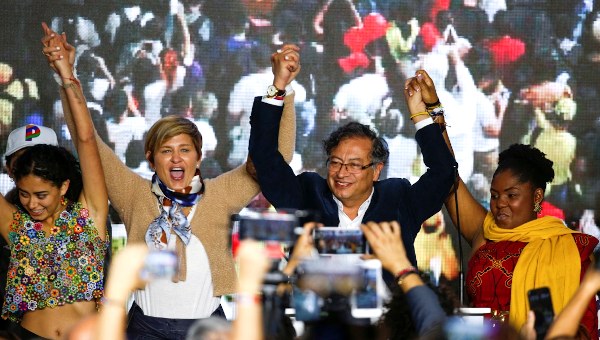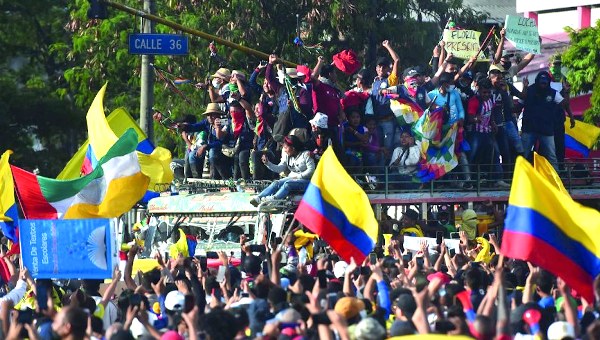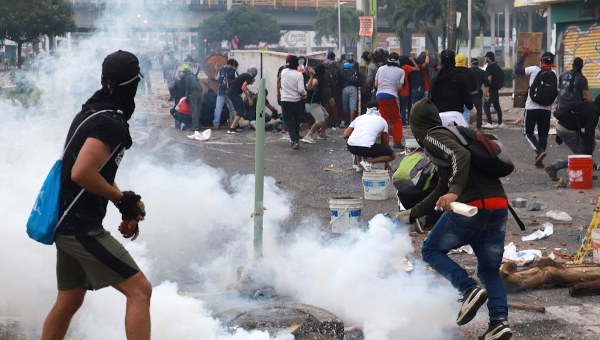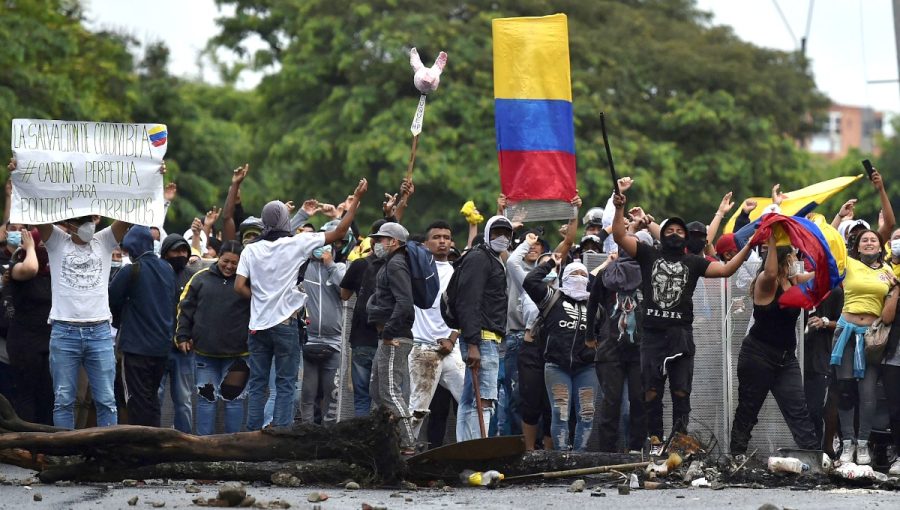The National Strike in Colombia: A Trade Union Perspective
For the past month and a half, Colombia has been gripped by social and political upheaval on a level unparalleled in the past half century. On 28 April, a national strike began that surged across the roads and avenues of more than 600 cities around the country, an unexpected but welcome surprise for the leaders of the strike committee and one that caught the national government entirely unprepared for the scale of the strike and its enormous popular support.
While the beginnings of this strike were directly tied to popular discontent with the government’s proposed tax reform bill, it was also a resurgence of the huge protests that enveloped Colombia from November 2019 to February 2020. But more than just a spontaneous reflection of the broad social crisis that has gripped Colombia for decades, the present context portends a much deeper, wider, and momentous social explosion.
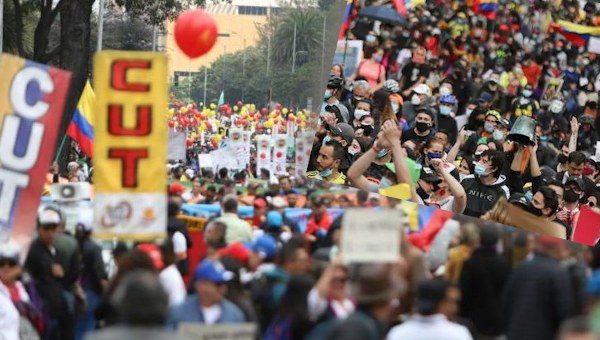
The National Context Before the Strike
The arrival of the Covid-19 pandemic in Colombia at the beginning of March 2020 was a blessing in disguise for Colombia’s national government. Facing four months of popular uprising and the biggest protest marches since the 1977 national strike, the opportunity to focus attention on a ‘common enemy’ offered President Iván Duque Márquez the chance to reinvigorate his waning appeal and fabricate an image of a strong and assertive leader.
The pandemic and the policies put in place to curb social and economic activity ensured that the already worn-out protests would simmer away without achieving any concrete political victories, while allowing the president and his government to continue relatively unchecked. Indeed, what was effectively the institutional shutdown of the country opened space for an executive-style coup of democracy, enabling governance by decree for the greater part of 2020 with little discord from the justice system and even less from a Congress riddled with parliamentarians from dynastic families embroiled in corruption and other criminal scandals (Reyes-Ramírez, 2017).
As Covid-19 ripped away at the already depleted and maimed privatized health system, leaving in its wake just under 96,000 related deaths by 14 June 2021, the government’s efforts to mitigate the socio-economic impacts of a year of policies to contain the spread of Covid-19 were tepid to say the least. While massive income-relief packages to residents stricken by containment-related policies became commonplace around the world, in Colombia the government preferred the tried, tested, and failed approach of only offering relief to a small percentage of the most affected households, while simultaneously pretending to protect businesses via loans that were controlled, and diluted, by the banking system. As poverty levels soared across the country, but especially in urban households, to encompass 21 million people at the start of 2021, the government’s poverty-alleviating statement policy, Solidarity Income, which comes to a measly $43 (US) a month, reached only 2.6 million people.
A Changing Horizon for Political Action
At the beginning of 2021, according to data from the National Department of Statistics, total unemployment came to 15%, with youth unemployment much higher at 23.9%, and female youth unemployment above 31% – this in a country where labour informality comes to more than 63%, where only 15% of the workforce earn the legal minimum monthly wage, and where 48% earn even less (Ortiz-Quevedo, 2021:45). By the end of 2020, monetary poverty had come to affect 42% of the population and, according to a national-level survey, nearly 66% of respondents had difficulty covering household expenses by June of this year, while 74% stated that to improve the economy it was necessary to increase taxes on the rich.
The response of the government was to give precedence to fiscal prudence and prioritize the interests of international creditors and rating agencies. Following on from the fast-tracked tax reform passed by Congress at the height of the 2019 protests, as well as the reform of 2016, which increased value-added tax from 16% to 19%, the government pushed forth a tax reform bill that maintained the exemptions and benefits given to the biggest firms and the wealthiest residents in 2019. At the same time, they attempted to finance the cost of the response to the pandemic via indirect taxes disproportionately paid for by the working and middle classes.
But this time, Colombia’s residents, so adept at enduring hardship, said no. The president, confident that this bill would pass relatively quickly through Congress, vowed to stare down public pressure. But Colombia after the peace agreement with the ex-guerrilla group Las FARC is a vastly different society where, despite government reticence to implement these agreements, people have taken to the streets en masse to oppose unpopular policies with an energy not seen in decades. As a last gasp attempt at gagging public resistance, Duque appeared on national television the day before the planned protests, calling on the public to stay at home during the third wave of Covid-19. A justice tribunal even went so far as to ban the protests due to the harm they would cause to public health – all to no avail.
The first week of the national strike went beyond anything the country had witnessed before, with city streets around the country alive with marches, dances, spontaneous concerts, and mass artistic expressions such as huge graffiti murals. As well, sporadic acts of looting and vandalism broke out in the face of the national government’s decision to militarize all cities and towns where protest marches and activities had displayed energy and persistence. This containment strategy would follow tradition: excessive state violence against unarmed protestors, with apparent collusion between the police and armed civilians. Indeed, based on various reports by internationally recognized human rights organizations, from the 28th of April up until the 31st of May, 45 people involved in the protests had been killed by the armed forces, with a further 187 civilians wounded, and a total of at least 1248 victims of physical violence, including acts of sexual assault against women, perpetrated by members of the armed forces, as well 409 forced disappearances (only 328 of whom have been ‘found’).
Faced with such severe repression, the protestors dug in and expanded their spheres of influence, setting up hundreds of blockades across the country, effectively slowing cross-territorial trade and transport to a snail’s pace. And despite the government’s violent tactics, at the beginning of June, general approval of the National Strike was still resounding, by upwards of 74%.
Highlighting the Political and Institutional Crisis
Not only has the government’s response of complete militarization failed but so too have its efforts at quelling discontent with a few faint-hearted promises. The ongoing protests have made vivid the emptiness of the president’s and his government’s political power, and the violent response of the state is the best illustration of its weakness and crisis of legitimacy (Valencia, 2021:37). Just days after the protests began, the magnitude of their strength was vivid. The protests forced the president to withdraw the tax reform bill from Congress and accept the resignation of the hugely unpopular minister of finance. They also ensured that the health reform bill was stillborn in Congress and, later, the resignation of Colombia’s chancellor, as international condemnation of the government’s handling of the strike grew.
The struggles in the streets continued up until 11 June, driven by the country’s youth and thousands of marginalized and discriminated-against communities, who are united in opposition to Colombia’s political and governing class but also seemingly disconnected from the institutional management of the protest movement in the hands of the National Strike Committee. This committee is made up of 20 members, primarily trade unionists, together with a minority of representatives from truck driver associations, students, and the LGBTI community. However, while the preparation and launching of the 28 April national strike was hugely successful, the heterogeneity, territorial decentralization, and youthful drive of the subsequent protest movements and activities has shown that the strike is no longer under the command and control of this committee. Furthermore, after initial progress, negotiations with the government stalled as, straight after approving a rough draft of an agreement concerning guarantees for social protest on 26 May, the government retracted their approval, demanding that all roadblocks be immediately lifted and that nothing would be agreed upon until everything was agreed.
On 8 June, in the face of intransigence on the part of the government, the strike committee formally left the negotiating table, caught in an untenable position of being called into bluff by a government lacking in political capital, while not having sufficient authority to be able to convince disparate protesters across the country to end their roadblocks. The committee’s efforts to broaden its base by inviting new voices to join its amplified assembly is noteworthy but insufficient, with frontline activists across various cities stating that this committee does not represent them. The problem, it seems, is not so much the demands, but rather, who the people are that present them and how. What has become obvious is the generational gap between the mainly youth protestors, who face unemployment, informality, and state exclusion, and the older trade union leaders who, while vociferously opposing regressive and repressive state policies, are nonetheless part of the existing institutional fabric, which has been shown to be anachronistic in the current climate of social upheaval.
After almost 45 days of protests and blockades, as the strike appears to have reached its end, the year ahead promises to be rife with further political and social turmoil. The government’s hope of taking advantage of the pandemic to push forth more unpopular bills, especially labour and pension reforms, is now off the agenda. Nevertheless, President Duque is vainly searching to regain some semblance of legitimacy by presenting projects that were taken directly from the strike committee’s list of demands, especially one for a basic income grant for poverty-stricken households.
The country looks on, ever-more divided by political polarizations fomented by the need to project fear as a means of selling security politics. But the 2019 protests and the most recent strike have clearly shown that in Colombia, after the peace agreements of 2016, when the extreme inequalities and structural deficiencies heightened and made starkly visible during the pandemic, fear mongering is not sufficient to quell the desire and demand for more concerted political and institutional change. •
This article first published on the Global Labour Column website.
References
- Ortiz-Quevedo, CH (2021) ‘Another twist: the greed of the elites in the pandemic’ [in Spanish], Pensar la Resistencia: Mayo del 2021 en Cali y Colombia, Documentos Especiales CIDSE 6.
- Reyes Ramírez, E. (2017) ‘Corruption and the Colombian state’, [in Spanish], Dictamen Libre, 21.
- Valencia, AG (2021) ‘What is happening in Colombia?¿Qué está pasando en Colombia? Power, legitimacy and the social crisis’ [in Spanish], Pensar la Resistencia. Mayo del 2021 en Cali y Colombia. Documentos Especiales CIDSE 6.


